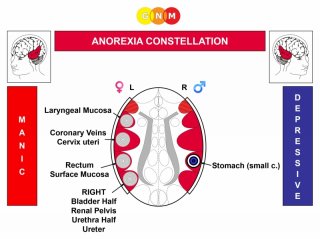ANOREXIA CONSTELLATION
Anorexia (anorexia nervosa) presents as compulsive fasting and a refusal to eat. Anorexics might weigh themselves several times a day. The fear of gaining weight is the main conflict track. A prolonged Anorexia Constellation causes extreme weight loss and can, therefore, be life-threatening.
NOTE: The territorial anger conflict or identity conflict (“not fitting in”) always involves distress concerning one’s weight, for example, upsetting or derogatory weight-related comments, being teased by male family members or schoolmates about one’s figure, being shamed as overweight, feeling inadequate vis-à-vis someone perceived as slimmer and, therefore, more attractive (a female friend, older sister, schoolmate, a model, a movie star).
|
According to the results of a report published in September 2013 in the American Academy of Pediatrics journal Pediatrics, “significant numbers of teenagers affected by anorexia actually begin to participate in disordered eating patterns while heavy enough to qualify for a diagnosis of obesity” (“Many Teens Develop First Signs of Anorexia While Obese”, Elements Behavioral Health, October 9, 2013).
|
Like with bulimia, the onset of anorexia occurs most commonly in young women in their teenage years. Young girls and adolescents are particularly susceptible to suffer conflicts associated with their weight because at this age they are more vulnerable concerning their looks. However, girls as young as 8 years have also become anorexic as well as women in their sixties. Boys and adult males have anorexia too.
Mental manifestation:
|
|
| |
|
| |
|
| |
| With a sexual conflict, cerebrally linked to the cervix uteri relay from where ovulation is controlled, the anorexic female stops menstruating. However, the termination of the menstrual cycle can also occur because of the low weight (estrogen production is dependent on body fat).
| |
| When the alpha islet cells are also affected (fear-disgust conflict or resistance conflict), the anorexic is, at the same time, bulimic. Forced vomiting, the use of laxatives or diet pills, or excessive exercises are means to prevent weight gain (compare with “pure” bulimics that can have normal body weight). Often, anorexics consider being fat as “disgusting”, which could keep a fear-disgust conflict active. Most bulimics have never been anorexic, but anorexics are often bulimic.
| |
| The majority of anorexics have a maturity stop since the conflicts usually occur during adolescence.
|
|


